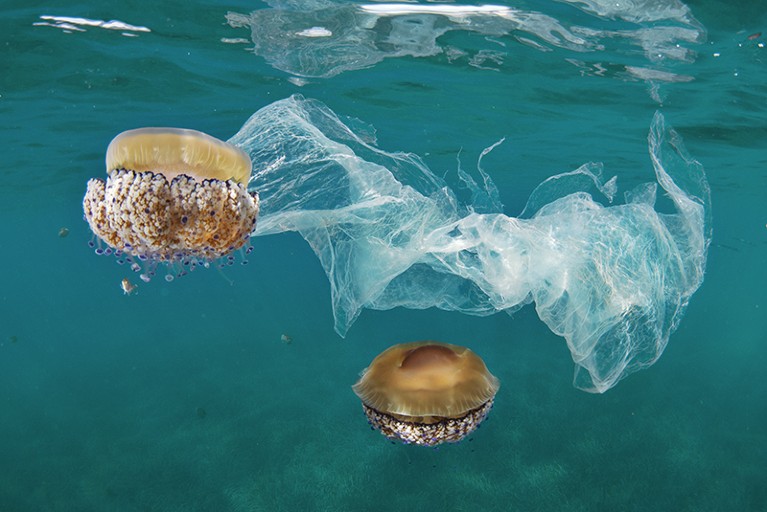Hello Nature readers, would you like to get this Briefing in your inbox free every day? Sign up here.

The oceans have become more polluted by large plastic objects such as bags over the past 60 years.Credit: Angel Fitor/Science Photo Library
Sixty years of data logs accidentally tracked the huge rise in ocean plastics
Scientists have found the first strong evidence of a massive rise in ocean plastic pollution over the decades from an unexpected source: log books for plankton-tracking vessels. The ships tow recording devices millions of kilometres across the Atlantic Ocean to survey plankton populations. Helpfully, 60 years of data logs also detail each time the instruments become entangled in large plastic objects, such as bags and fishing lines, showing an increasing trend: these encounters have occurred three times more often since 2000 than in preceding decades.
Reference: Nature Communications paper
Malaria vaccine offering 100% protection faces first large field trial
A malaria vaccine that can provide up to 100% protection against the disease will be tested in a large clinical trial for the first time. In lab studies, the vaccine, called PfSPZ, has proved to be the most effective one developed for malaria so far, giving healthy volunteers complete protection. Early next year, it will be tested in 2,100 people on the island of Bioko, off the coast of Equatorial Guinea, to see how it fares in real-world conditions.
IndiaRxiv is the latest regional preprint repository
Researchers in India will soon have their own preprint repository where they can post manuscripts from any discipline. IndiaRxiv will be accepting submissions in English and any Indian language from the end of April. The platform’s founders hope that it will improve research quality and reduce scientists’ reliance on predatory journals.
Kids keep shoving stuff in their mouths
If you spend any time around small children, you’ll know they have a tendency to put things in their mouths that absolutely should not go in their mouths. A US study suggests that there’s been a sharp rise in the number of children swallowing small objects, with the number doubling between 1995 and 2015. Coins were by far the most common type of object swallowed, but there was also a 60-fold increase in the proportion of children ingesting batteries over the 20-year period.

US professor cleared of involvement in CRISPR-babies experiment
Earlier this week, we highlighted a New York Times article revealing an investigation into a Stanford University scientist accused of assisting with last year’s controversial experiments to make gene-edited babies using CRISPR. The NYT has now followed up on the claims, saying that the university has cleared Stephen Quake of any wrongdoing in his interactions with He Jiankui, the scientist behind the work. It notes that Quake in fact discouraged He from pursuing the project, and urged him to follow proper scientific practices after he insisted on going ahead.
FEATURES & OPINION

David Edwards, a Mutthi Mutthi elder, welcomes the return of remains that had been taken long ago.Credit: Lisa Maree Williams/Getty
Indigenous groups look to ancient DNA to bring their ancestors home
Researchers are partnering with Indigenous communities to create genomic maps that connect ancient and historical remains with present-day groups. Such catalogues could eventually be used to help return more remains to their homelands.
How to lead a lab from 18,900 kilometres away
Thomas Bennett jumped at the opportunity to do a visiting fellowship in New Zealand earlier this year, but as the leader of a research group in the United Kingdom, it naturally led to some practical and logistical complications back home. Here’s how he handled it.
